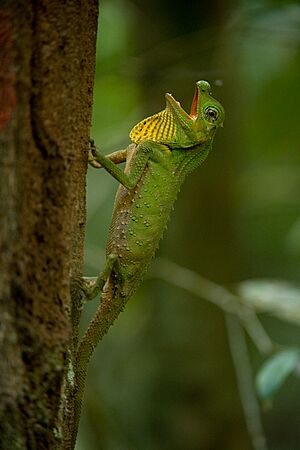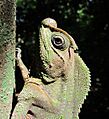Hump-nosed lizard facts for kids
Quick facts for kids Hump-nosed lizard |
|
|---|---|
 |
|
| Conservation status | |
| Scientific classification | |
| Genus: |
Lyriocephalus
|
| Species: |
scutatus
|
 |
|
The Hump-nosed Lizard (scientific name: Lryiocephalus scutatus) is a special type of lizard. It belongs to the agamid family. This lizard is the biggest agamid found only in Sri Lanka. It lives in thick, wet forests there. People also call it the hump snout lizard or the lyreshead lizard. In Sri Lanka, it's known as "Kandukara Bodilima – කදුකර බෝදිලිමා" in the Sinhalese language.
Where It Lives
The Hump-nosed Lizard lives in many places across Sri Lanka. You can find it in wet lowlands and also in the mid-hills. It lives at different heights, from about 25 meters (82 feet) up to 1,650 meters (5,413 feet) above sea level.
What It Looks Like
This lizard has a body that looks flattened from side to side. It has two small spines at the back of its head. There's also a ridge, called a crest, along its back and neck. The scales on its forehead have a raised line, making them "keeled."
Adult Hump-nosed Lizards have a clear bony arch or hump on their head. This special feature gives them their name. They don't have an eardrum that you can see. They also have a V-shaped pouch under their chin, called a gular sac. The scales on this pouch are large and keeled. Its tail is short and flattened, with a blunt tip.
The back of the lizard is usually light green. Its throat is yellow. The rest of its belly is a creamy color.
- Males: Are often bright green with a yellow throat pouch and a "sail" on their neck.
- Females: Can also be green, but they are usually brown, especially when a male is nearby.
- Young Lizards: Are typically brown.
Daily Life and What It Eats
The Hump-nosed Lizard lives in forests with tall trees and thick plants on the ground. Sometimes, it might even visit home gardens. It is active during the day. You can often see it low on trees or walking on the ground. At night, it climbs higher up into the trees to sleep.
When this lizard feels threatened, it opens its mouth wide. This shows the bright red lining inside its mouth. This is a warning sign to scare away danger. It is also known to pretend to be dead if someone picks it up.
Its main food is earthworms. It also eats other small creatures like insects. These include termites, butterflies, and moths. Sometimes, it will even munch on young plant shoots and buds.
Reproduction
Female Hump-nosed Lizards lay eggs several times a year. They can lay between 1 and 11 eggs in one clutch. The eggs are about 12–13 mm wide and 20–22 mm long. They lay eggs in January, March, May, June, September, October, and December.
The eggs are buried in the soil after they are laid. Sometimes, they are hidden under bushes. It takes about 35 days for the eggs to hatch.
Images for kids





